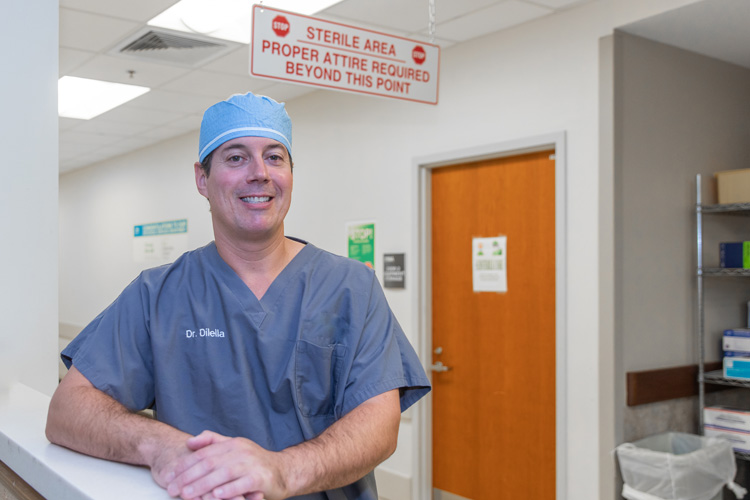
The older we get the more likely we are to suffer complex bone fractures – particularly in our shoulders and arms.
The Department of Orthopedic Surgery at the Philadelphia College of Osteopathic Medicine puts it plainly. “Elderly patients,” it says, “are much more prone to have more complex bone fractures and poor bone quality compared to their younger counterparts.”
Dr. Carl DiLella, who is with the Orthopedic Center of Vero Beach, and who received his own medical degree from that renowned Philadelphia orthopedic center, has taken a special interest in treating such fractures – including shoulder breaks known as “proximal humerus fractures” (PHFs), which the National Institutes of Health says have been “rapidly rising” nationwide.
According to the NIH, “PHFs have increased by more than 40 percent over the past five years, making them the third most common non-vertebral fracture pattern seen in the elderly.”
“Unfortunately,” DiLella explains, “many elderly people have these injuries, usually from a trauma or a fall. I’ve had people trip over a parking brick in parking lot or they miss a step going down from a curb from a sidewalk. They lose their footing or their balance and down they go onto their shoulder.
“If there’s enough force behind that situation, they will sometimes break the bone around the shoulder. The main one being the proximal humerus that makes up the ball of the ball and socket joint of the shoulder.”
DiLella goes on to share both good and bad news about such injuries.
There are, he explains, many different types of shoulder bone breaks.
With a simple break, DiLella continues, the prognosis is also simple. That conversation, he says, might go like this: “‘OK, Mrs. Jones, you have a simple two-part proximal humerus fracture. Two simple parts of your shoulder are broken and you will be in an arm sling for about a month. Then you’ll come back and I’ll take an X-ray in a month to show you that it’s healed,’ and Mrs. Jones will go to physical therapy and have a happy life. And a happy shoulder.”
But when the bone is fractured in multiple places things get trickier and surgery may be required. But which surgery?
In some cases, depending on what X-rays or CAT scans reveal, the insertion of plates and screws may hold the bone together, but with other multiple fractures, treatment can be more complex.
In the not-too-distant past that usually involved a procedure known as a “hemiarthroplasty” or a “hemi” which, in layman’s terms, replaced one half of the shoulder joint. The humeral head (or ball) was replaced with a prosthesis while the existing glenoid (socket) was left intact.
Often, however, as DiLella says, “this made for really pretty-looking X-rays but very poor outcomes for the patient.”
Fortunately, times and procedures change, and today “reverse total shoulder arthroplasty or RTSA is the treatment of choice” for that kind of complex break, according to NIH.
In a RTSA, a prosthetic ball is placed on the socket side of the joint – the opposite or “reverse” of where it is in nature – and a prosthetic socket is then placed on the arm side where it is supported by a metal stem in the arm bone or humerus.
As an added bonus, with the RTSA procedure, rotator cuff tears or injuries are no longer a potential future problem.
As DiLella explains, “you bypass the rotator cuff completely by implanting this device. The reason why is [the new reverse joint] relies on the deltoid muscle, which is rarely, if ever, affected by a fracture or a fall.”
“The surgery,” DiLella continues, “is usually done here at the hospital and the patient would spend one night. When the patient wakes up from the operation they’re very comfortable. They’re protected in an arm sling that we provide them [and they] would spend one night and then they go home the next day.”
Johns Hopkins says these RTSA procedures “give the patient significant pain relief and also help restore range of motion to the shoulder.”
Others clearly agree. By 2015 the use of the RTSA procedure, which debuted in 1987, surpassed the older hemiarthroplasty approach for the first time and that lead continues to grow today.
In fact, NIH says hemiarthroplasty appears to be “falling out of favor in the treatment of fractures of the shoulder,” with RTSA taking its place.
If you’ve had a fall and suspect a fracture of your shoulder, talk to your orthopedist. A minimally invasive procedure like RTSA could well be the best way to eliminate your pain and restore your arm’s range of motion for “a happy shoulder and a happy life.”
Dr. Carl DiLella is with the Orthopedic Center of Vero Beach and the Cleveland Clinic Indian River Hospital. His office is at 1285 36th St., Suite 100. The phone number is 772-778-2009.



